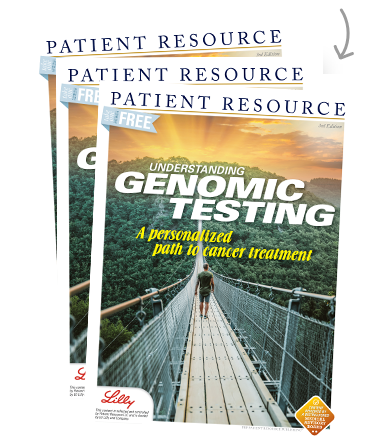Understanding the Genomics and Genetics of Cancer
Glossary
Adjuvant therapy — Additional cancer treatment given after primary treatment to lower the risk the cancer will come back.
Cytogenetics — The study of chromosomes to look for changes, including broken, missing, rearranged or extra chromosomes.
DNA — Deoxyribonucleic acid. The molecules inside cells that carry genetic information that is passed from one generation to the next.
DNA sequencing — A laboratory process used to find DNA mutations (changes) that may cause diseases, such as cancer.
First-line therapy — The first treatment used.
Fluorescence in situ hybridization (FISH) — FISH can be used to identify where a specific gene is located on a chromosome, how many copies of the gene are present and any chromosome abnormalities.
Genome — The complete set of DNA (genetic information) in an organism.
Genomic sequencing — A procedure that determines the entire genetic makeup of an organism or cell type to diagnose and treat cancer.
Histologic grade — Description of a tumor based on how abnormal the cancer cells and tissue look under a microscope. It also helps determine how quickly the cancer cells are likely to grow and spread.
Immunotherapy — Also referred to as immune-oncology, treatment designed to enhance the patient’s own immune system to fight the cancer.
Liquid biopsy — A test done on a sample of blood to look for cancer cells or pieces of DNA from a tumor that are circulating in the blood. May be used to help plan treatment, determine treatment effectiveness and identify cancer that has returned.
Local treatment — Directed to a specific organ or limited area of the body, it includes surgery, radiation therapy and topical therapy (a lotion or cream that is applied to the skin).
Molecular testing — Uses a sample of tissue, blood or other body fluid to check for certain genes, proteins or other molecules; also looks for gene or chromosome changes that may affect the chance of developing cancer. Helps diagnose some types of cancer, plan treatment, monitor treatment effectiveness or predict outcome.
Mutations — Changes from an individual’s genetic code when compared to the human reference sequence.
Neoadjuvant therapy — Treatment given to shrink a tumor before the main treatment (usually surgery) is given.
Next-generation sequencing (NGS) — Tests that detect sections of DNA that represent changes, including insertions or deletions, in a specific DNA sequence.
Pathologic stage — The stage of cancer based on histologic grade.
Second-line therapy — Given when the first-line therapy does not work or is no longer effective.
Standard of care — The most widely accepted treatment known for the type and stage of a particular cancer.
Systemic therapy — Drug therapy that travels throughout the body.
Tumor microenvironment — The cells, molecules and structures that surround and support a tumor.



